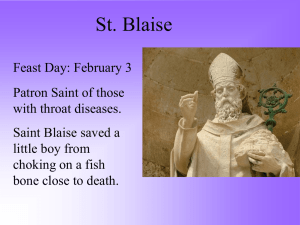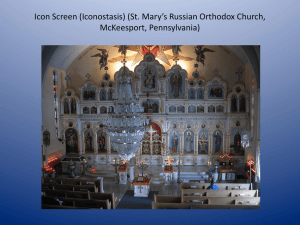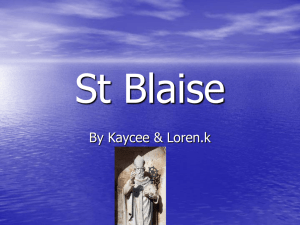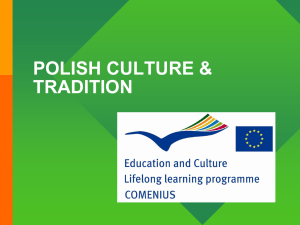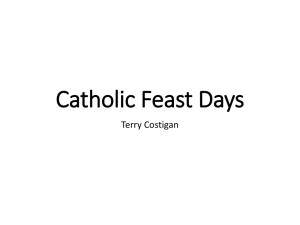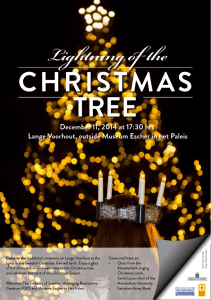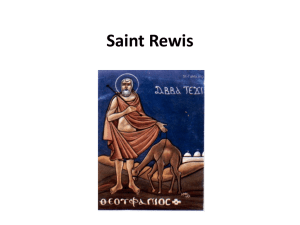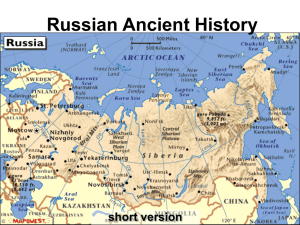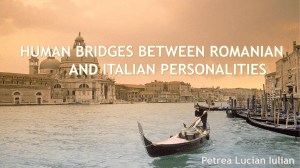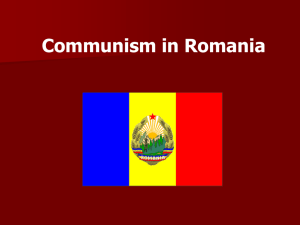Diary of Festivities - "Nicolae Iorga" Negresti
advertisement
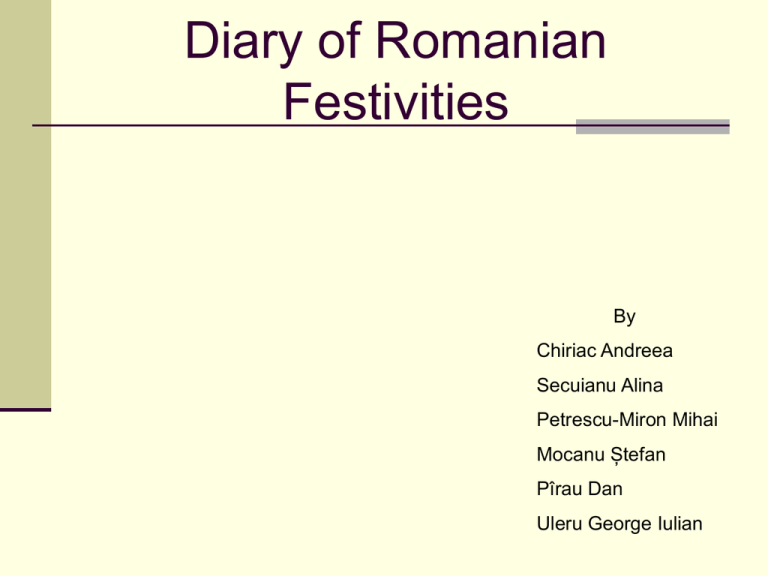
Diary of Romanian Festivities By Chiriac Andreea Secuianu Alina Petrescu-Miron Mihai Mocanu Ștefan Pîrau Dan Uleru George Iulian Product made for the project: Intercultural Dialogue as a Means to Develop Creativity and Innovation This project has been funded with support from the European Commission. This publication reflects the views only of the author, and the Commission cannot be held responsible for any use which may be made of the information contained therein. Saint Basil - 1st of January Basil of Caesarea, also called Saint Basil the Great, was the bishop of Caesarea Mazaca in Cappadocia, Asia Minor (modern-day Turkey). He was an influential 4th century Christian theologian and monastic. Theologically, Basil was a supporter of the Nicene faction of the church, in opposition to Arianism on one side and the followers of Apollinaris of Laodicea on the other. His ability to balance his theological convictions with his political connections made Basil a powerful advocate for the Nicene position. During the Christmas period until St. Basil’s Day (January 1st ) in Maramures, the magical practice is known as “the tying up of the beast in the forest”, which consists of laying a loaf of ritual bread, named High Steward, on the table, which is then tied with an iron chain. After 8 days, on New Year’s Day, the loaf of bread is cut into slices eaten by children and animals, and the chain is put in front of the stable, so that the cattle may step over it. Epiphany – 6th of January Epiphany is celebrated by both the Eastern and Western Churches, but a major difference between them is precisely which events the feast commemorates. For Western Christians, the feast primarily commemorates the coming of the Magi; Eastern churches celebrate the Baptism of Christ in the Jordan. In both traditions, the essence of the feast is the same: the manifestation of Christ to the world (whether as an infant or in the Jordan), and the Mystery of the Incarnation. Epiphany is a Christian feast day which celebrates the revelation of God in human form in the person of Jesus Christ. It falls on January 6 or on a Sunday close to that date. January 6 in the Julian Calendar, which is followed by some Eastern Churches, corresponds at present to January 19 in the Gregorian Calendar, which is the official civil calendar in most countries. On this day, Western Christians commemorate principally the visitation of the Biblical Magi to the child Jesus, i.e., his manifestation to the Gentiles; Eastern Christians commemorate the baptism of Jesus in the Jordan River, seen as his manifestation to the world as the Son of God. It is also called Theophany, especially by Eastern Christians. Valentine's Day – 14th of February Valentine's Day is a holiday celebrated on February 14 by many people throughout the world. In the English-speaking countries, it is the traditional day on which lovers express their love for each other by sending Valentine's cards, presenting flowers, or offering confectionery. The holiday is named after two among the numerous Early Christian martyrs named Valentine. Dragobete – 24th February . Dragobete was the son of Baba Dochia. While Valentine’s Day is mostly related to people and their actions in the name of love, the Romanian holiday dedicated to love, Dragobete, is strongly connected to nature. Celebrated on February 24th, it is linked to that special time of year when birds build their nests and mate. As the first signs of spring show, nature and man restart the cycle of life and love Mărțișor – 1st of March Mărţişor is the traditional celebration of the beginning of the spring in Romania, Moldova, Bulgaria and Macedonia, on 1 March. The day's name is the diminutive of March (in Romanian Martie), and thus means something like "little" or "dear March". Nowadays, men offer women a talisman object also called Mărţişor, consisting of a jewel or a small decoration like a flower, an animal or a heart, tied to a red and white string. However, giving a little nickel tied to a red and white string is an old custom and was originally designated for both men and women. It was believed that the one who wears the red and white string will be powerful and healthy for the year to come. The decoration is a symbol of the coming spring. A woman wears it pinned to her blouse on this day and up to two weeks after. In some parts of Romania such as Moldova or Bukovina the symbol of spring was a gold or silver medal which was worn around the neck. International Women's Day 8th of March International Women's Day (IWD) is marked on March 8 every year. It is a major day of global celebration for the economic, political and social achievements of women. Started as a political event, the holiday blended in the culture of many countries (primarily Russia and the countries of former Soviet bloc). In some celebrations, the day lost its political flavour, and became simply an occasion for men to express their love to the women around them in a way somewhat similar to Mother's Day and St Valentine's Day mixed together. In others, however, the political and human rights theme as designated by the United Nations runs strong, and political and social awareness of the struggles of women worldwide are brought out and examined in a hopeful manner. Easter Easter is the most important annual religious feast in the Christian liturgical year. According to Christian scripture, Jesus was resurrected from the dead on the third day of his crucifixion. Christians celebrate this resurrection on Easter Day or Easter Sunday, two days after Good Friday and three days after Maundy Thursday. Easter also refers to the season of the church year called Eastertide or the Easter Season. Traditionally the Easter Season lasted for the forty days from Easter Day until Ascension Day but now officially lasts for the fifty days until Pentecost. The first week of the Easter Season is known as Easter Week or the Octave of Easter. Easter also marks the end of Lent, a season of fasting, prayer, and penance. Easter is the most important celebration of the Romanian people and it is preceded by numerous preparations and rituals. May Day – 1st of May May Day occurs on May 1 and refers to several public holidays. In many countries, May Day is synonymous with International Workers' Day, or Labour Day, a day of political demonstrations and celebrations organised by the unions and socialist groups. May Day falls exactly half of a year from November 1, another cross-quarter day which is also associated with various northern European pagan and neopagan festivals such as Samhain. May Day marks the end of the uncomfortable winter half of the year in the Northern hemisphere, and it has traditionally been an occasion for popular and often raucous celebrations, regardless of the locally prevalent political or religious establishment. Europe Day 9th of May In Europe, Europe Day is an annual celebration of peace and unity in Europe. There are two separate Europe Days, taking place on 5 May and 9 May, established by the Council of Europe (CoE) and the European Union (EU) respectively. For the EU, the day is also known as Schuman Day. The Council of Europe's day reflects its own establishment in 1949, while the European Union's day celebrates the day the EU's predecessor was proposed in 1950. Europe Day is one of a number of European symbols designed to foster unity among Europeans. Saint Constantine and Helena 21th of May Constantine began the Roman Empire's unofficial sponsorship of Christianity, which was a major factor in the faith's spread. The Orthodox Church keeps his feast on May 21, along with his mother, Empress Saint Helen. Child’s Day – 1st of June Children's Day is an event celebrated on various days in many places around the world. International Children's Day is celebrated on June 1 and Universal Children's Day is on November 20. The holiday is simply set to honor children and minors. Saints Archangels Michael and Gabriel Michael was regarded as the Chief of the Order of Virtues, Prince of the Presence, Chief of Archangels, the Angel of Repentance, Righteousness, Mercy, and Sanctification. He is also Ruler of the 4th Heaven and Conqueror of Satan. Gabriel is the Angel of annunciation, resurrection, mercy, vengeance, death and revelation. In the Gospel of Luke, the Archangel Gabriel serves as the messenger of God and shares with Mary that she will give birth to a son of God whom she will call Jesus, a moment captured frequently in paintings as the Annunciation. Saint Peter and Paul • Saints Peter and Paul are the principle pillars of the Church founded by Christ. Saint Paul was chosen to form part of the apostolic college by Christ himself on the road to Damascus. Saint Peter was chosen by Christ to be his first Vicar on earth; he was endowed with powers ofthe keys of the kingdom of heaven Saint John the Baptist – 24th June Sânzienele The Eastern Orthodox believe that John was the last of the Old Testament prophets, thus serving as a bridge between that period of revelation and the New Covenan. They also teach that, following his death, John descended into Hades and there once more preached that Jesus the Messiah was coming, so he was the Forerunner of Christ in death as he had been in life. According to Sacred Tradition, John the Baptist appears at the time of death to those who have not heard the Gospel of Christ, and preaches the Good News to them, that all may have the opportunity to be saved. Orthodox churches will often have an icon of St. John the Baptist in a place of honor on the iconostasis, and he is frequently mentioned during the Divine Services. Every Tuesday throughout the year is dedicated to his memory In the Eastern Orthodox Church and other Eastern Christian Churches, St John the Baptist is usually called St John the Forerunner, a title used also in the West. This title indicates that the purpose of his ministry was to prepare the way for the coming of Jesus Christ. In the East also, the Feast of his Nativity is celebrated on 24 June. It is a major feast day and is celebrated with an All-Night Vigil. It has an Afterfeast of one day. The feast always falls during the Apostles' Fast. The Dormition of the Theotokos 15th of August The Dormition (Falling Asleep) of the Theotokos is one of the Great Feasts of the Orthodox Church, celebrated on August 15. This feast, which is also sometimes called the Assumption, commemorates the death, resurrection and glorification of Christ's mother. It proclaims that Mary has been "assumed" by God into the heavenly kingdom of Christ in the fullness of her spiritual and bodily existence. The feast is preceded by 14 days of strict fasting, with the exceptions that fish is eaten on the Feast of the Transfiguration (August 6). On weekdays before the feast, either the Great Paraklesis (service of supplication) or the Small Paraklesis is celebrated. The Nativity of the Theotokos 8th of September The Holy Virgin and Theotokos Mary was born to elderly and previously barren parents by the names of Joachim and Anna, in answer to their prayers. The Nativity of the Theotokos is one of the Great Feasts of the Orthodox Church, celebrated on September 8. The feast of the Nativity of the Theotokos, therefore, is a glorification of Mary's birth, of Mary herself and of her righteous parents. It is a celebration as well of the very first preparation of the salvation of the world. For the "Vessel of Light," the "Book of the Word of Life," the "Door to the Orient," the "Throne of Wisdom" is being prepared on earth by God himself in the birth of the holy girl-child Mary. Saint Demetrius of Thessaloniki 26th of October Saint Demetrius of Thessaloniki was a Christian martyr, who lived in the early 4th century. During the Middle Ages, he came to be revered as one of the most important Orthodox military saints, often paired with Saint George. His feast day is 26 October for Christians following the Gregorian calendar and 8 November for Christians following the Julian calendar. The spelling "Demetrius" is a romanization of the ancient Greek pronunciation; the Byzantine and Modern Greek pronunciation is romanized as Dimitrios. Saint Andrew – November 30th The name "Andrew", like other Greek names, appears to have been common among the Jews from the second or third century BC. Andrew the Apostle, called in the Orthodox tradition Protokletos, or the First-called, is a Christian Apostle and the brother of Peter the Apostle. The official stance of the Romanian Orthodox Church is that Andrew preached the Gospel to the Daco-Romans in the province of Dobrogea (Scythia Minor), whom he converted to Christianity. Nevertheless, these claims that are supported by little historical evidence, are usually part of the nationalist protochronism ideology, supported by the Orthodox Church, which argues that the Church has been a companion and defender of the Romanian people for all of their 2000-year history. National day of Romania December 1st December 1st is the National day of Romania. For the Romanian people, the year 1918 represents the triumph of the national ideal after a long time of fights and human and material sacrifices for achieving the national unitary state. This historical process developed on the entire Romanian area scored important marks in 1784, 1821, 1848-49, the unification of Moldavia with Muntenia in 1859, the Proclamation of the Absolute Independence after the 1877-78 war and the representative meetings democratically selected of the Romanians living under foreign domination in Chisinau, Cernauti and Alba Iulia in 1918. Great Union Day – 1st of December Great Union Day occurring on December 1, is the national holiday of Romania. It commemorates the assembly of the delegates of ethnic Romanians held in Alba Iulia, which declared the Union of Transylvania with Romania. In Communist Romania, the date of the national holiday was set to August 23 to mark the 1944 overthrow of the pro-fascist government of Marshal Ion Antonescu. Saint Nicholas – December 6th Saint Nicholas is the common name for Nicholas of Myra, a saint and Bishop of Myra. Because of the many miracles attributed to his intercession, he is also known as Nicholas the Wonderworker. The tradition of Saint Nicholas Day, usually on 6 December, is a festival for children in many countries in Europe related to surviving legends of the saint, and particularly his reputation as a bringer of gifts. In Romania children typically leave their boots on the windowsill on the evening of December 5. By next morning Nicholas leaves candy and gifts if they have been good, or a rod (Romanian: nuieluşǎ) if they have been bad (most kids end up getting small gifts but also a small rod). St. Nicolas is also the protector saint of our highschool. Constitution Day of Romania – December 8th Constitution Day of Romania was celebrated for the first time in 1995, as a decision of the Parliament. The 1991 Constitution enshrined the return to democracy after the fall of the Communist regime. The draft was composed by a committee of parliamentarians and constitutional law specialists; was approved by Parliament, meeting as a Constituent Assembly, by a vote of 414 to 95 on 21 November 1991, being published in Monitorul Oficial the same day; and was approved by referendum on 8 December 1991, with 77.3% voting in favour. The 1991 Constitution contains 7 titles and 152 articles. Romania is defined as a “national, sovereign, independent, unitary and indivisible state”. The form of government is the republic, the president having up to two five-year terms. Christmas – December 25th Even in countries where there is a strong Christian tradition, Christmas celebrations can vary markedly from country to country. For many Christians, a religious service plays an important part in the recognition of the season. Family reunions and the exchange of gifts are a widespread feature of the season. Gift giving takes place on Christmas Day itself in most countries. The most famous and pervasive of the figures associated with Christmas in modern celebration worldwide is Santa Claus, a mythical gift bringer, dressed in red, whose origins have disputed sources. The Christmas tree is often explained as a Christianisation of pagan tradition and ritual surrounding the Winter Solstice, which included the use of Christmas or Christmas Day is evergreen boughs, and an adaptation of pagan tree an annual holiday, celebrated on worship. Romanian Christmas food generally use pork December 25, that (except Advent food). commemorates the birth of Jesus of Nazareth. In Pork meat, animal's organs, fat and blood. Christianity, Christmas is the Everything swine has inside is used. Some of them are festival celebrating the Nativity used for Christmas holidays, others are prepared to be of Jesus eaten later, till in spring. Saint Stephen – December 27th Saint Stephen, known as the Protomartyr of Christianity, is venerated as a saint in the Roman Catholic, Anglican, Lutheran and Eastern Orthodox Churches. He was one of the first in the early Church to wear the title Archdeacon. Acts of the Apostles tells the story of how Stephen was tried by the Sanhedrin (high priests) for blasphemy against Moses and God and speaking against the Temple and the Law. He was stoned to death by an infuriated mob encouraged by Saul of Tarsus, the future Saint Paul. Saint Stephen's name is simply derived from the Greek Stephanos, meaning "crown". Traditionally, Saint Stephen is invested with a crown of martyrdom for Christianity; he is often depicted in art with three stones and the martyr’s palm. In Eastern Christian iconography, he is shown as a young beardless man with a tonsure, wearing a deacon's vestments, and often holding a miniature church building or a censer.
